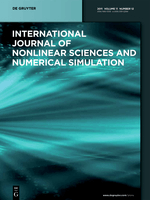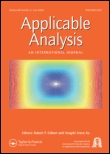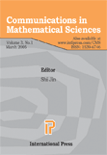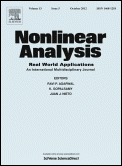
ZEITSCHRIFT FUR ANGEWANDTE MATHEMATIK UND PHYSIK
Scope & Guideline
Pioneering Research for Tomorrow’s Scientific Challenges
Introduction
Aims and Scopes
- Mathematical Modeling of Physical Systems:
Research papers often explore mathematical models that describe various physical systems, including fluid dynamics, thermodynamics, and biological processes. These models are critical for simulating real-world scenarios and predicting system behavior. - Analysis of Partial Differential Equations (PDEs):
The journal extensively covers the analysis of PDEs, which are central to formulating and solving problems in applied mathematics and physics. This includes studies on existence, uniqueness, and regularity of solutions. - Numerical Methods and Simulations:
A significant portion of the publications focuses on developing and analyzing numerical methods for solving complex mathematical models. This includes finite element methods, spectral methods, and other computational techniques. - Stability and Dynamics of Solutions:
Many articles investigate the stability properties of solutions to differential equations, particularly in relation to dynamical systems. This includes bifurcation theory and stability analysis in various contexts. - Interdisciplinary Applications:
Research often highlights interdisciplinary applications of mathematical theories in engineering, biology, and environmental sciences, bridging gaps between pure mathematics and practical applications. - Emerging Mathematical Techniques:
The journal also presents novel mathematical techniques that advance theoretical understanding or improve computational efficiency, such as fractional calculus, nonlocal models, and stochastic processes.
Trending and Emerging
- Complex Systems and Interactions:
There is a growing trend towards studying complex systems, including interactions within biological models, ecological systems, and multi-species interactions, highlighting the intricate dynamics that govern these systems. - Fractional and Nonlocal Models:
Research incorporating fractional calculus and nonlocal effects is on the rise, indicating a shift towards understanding phenomena that cannot be adequately described by classical local models. - Stochastic and Random Processes:
An increasing number of publications focus on stochastic models, reflecting the importance of randomness and uncertainty in physical systems, particularly in fields like epidemiology and finance. - Machine Learning and Data-Driven Approaches:
The integration of machine learning techniques into mathematical modeling and analysis is emerging as a significant trend, showcasing the journal's adaptation to contemporary computational methodologies. - Multi-Scale Modeling:
There is a notable trend towards multi-scale modeling approaches that bridge different scales of analysis, from microscopic to macroscopic phenomena, thus providing a more comprehensive understanding of complex systems. - Thermal and Fluid Dynamics in Nonlinear Regimes:
Research focusing on nonlinear effects in thermal and fluid dynamics is increasingly prominent, underlining the complexity and richness of these physical phenomena.
Declining or Waning
- Traditional Analytical Methods:
There is a noticeable decline in papers that rely solely on traditional analytical approaches without incorporating modern computational techniques. As computational power increases, researchers are increasingly favoring numerical simulations over purely analytical solutions. - Static Models Without Dynamic Considerations:
The focus on static models has decreased, with more researchers recognizing the importance of dynamic behavior and temporal effects in their models, leading to a waning interest in static equilibrium analyses. - Elementary Mathematical Techniques:
Papers that utilize basic mathematical techniques without innovative adaptations are becoming less frequent, as there is a push towards more sophisticated and robust methodologies in tackling complex problems. - Low-dimensional Systems:
Research on low-dimensional systems, such as simple ODEs or basic PDEs, is declining in favor of more complex, high-dimensional models that reflect real-world complexities and interactions.
Similar Journals

INTERNATIONAL JOURNAL OF NONLINEAR SCIENCES AND NUMERICAL SIMULATION
Pioneering Research in Nonlinear PhenomenaINTERNATIONAL JOURNAL OF NONLINEAR SCIENCES AND NUMERICAL SIMULATION, published by WALTER DE GRUYTER GMBH, serves as a premier platform for advancing knowledge in the vibrant domains of applied mathematics, computational mechanics, and various fields of engineering and physics. With an ISSN of 1565-1339, this journal has been at the forefront of disseminating significant research findings since its inception in 2000. Its commitment to quality is reflected in its category quartiles for 2023, ranked Q2 in Computational Mechanics and Engineering (miscellaneous), and Q3 in multiple engineering disciplines. Although it currently operates under a subscription model, the journal remains dedicated to presenting groundbreaking studies that explore complex nonlinear phenomena and numerical methodologies. As an invaluable resource for researchers, professionals, and students alike, the journal aims to foster innovation and collaboration across related fields, enhancing both theory and application through its peer-reviewed articles.

Proceedings of the Institute of Mathematics and Mechanics
Connecting Ideas, Cultivating Knowledge in MathematicsProceedings of the Institute of Mathematics and Mechanics is a pivotal journal in the field of mathematics, dedicated to the advancement and dissemination of cutting-edge research in various sub-disciplines. Published by INST MATHEMATICS & MECHANICS, NATL ACAD SCIENCES AZERBAIJAN, this journal plays a significant role in bridging local and international research communities. With an ISSN of 2409-4986 and E-ISSN of 2409-4994, it has gained recognition, attaining a Q3 ranking in the Miscellaneous Mathematics category and placing in the 67th percentile on Scopus. Run from 2017 to 2024, the journal serves as an accessible platform for scholars and practitioners, inviting contributions that advance theoretical knowledge and practical applications in mathematics. With an emphasis on quality and innovation, the Proceedings of the Institute of Mathematics and Mechanics stands out as a vital resource for those looking to stay at the forefront of mathematical research and its multifaceted applications in various fields.

Afrika Matematika
Advancing mathematical frontiers in Africa and beyond.Afrika Matematika is a prominent academic journal published by SPRINGER HEIDELBERG, dedicated to advancing research in the field of mathematics. With an ISSN of 1012-9405 and E-ISSN of 2190-7668, the journal has earned recognition for its contributions to diverse areas within mathematics, particularly through its designation in the Q3 quartile of the 2023 mathematics category and ranking 113 out of 399 in general mathematics on Scopus, reflecting a commendable 71st percentile standing. Covering a wide array of topics, the journal serves as an essential platform for researchers, professionals, and students engaged in mathematical studies and practical applications. Although not open access, Afrika Matematika maintains a rigorous peer-review process to ensure the high quality and relevance of its published articles, which are pivotal in shaping the mathematical landscape in Africa and beyond. With a convergence of scholarly work spanning from 2011 to 2024, this journal underscores its commitment to fostering a vibrant academic community that inspires innovation and collaboration in mathematical research.

APPLICABLE ANALYSIS
Elevating the discourse in applied mathematics.APPLICABLE ANALYSIS, published by Taylor & Francis Ltd, is an esteemed journal dedicated to advancing research in the fields of analysis and applied mathematics. With its ISSN 0003-6811 and E-ISSN 1563-504X, the journal has been a cornerstone of scholarly communication since its inception in 1971, with a convergence of content projected until 2024. Belonging to the Q2 category for both Analysis and Applied Mathematics as of 2023, it ranks impressively at #58 out of 193 in the field of Mathematics Analysis and #274 out of 635 in Mathematics Applied Mathematics as per Scopus metrics. Although the journal currently does not offer Open Access, it continues to provide valuable insights and cutting-edge research that is vital for academics, professionals, and students who seek to deepen their understanding and application of analytical techniques in various contexts. Its commitment to high-quality research plays a significant role in shaping the landscape of modern mathematics.

International Journal of Mathematics and Physics
Advancing Knowledge through Collaborative ScholarshipThe International Journal of Mathematics and Physics, published by AL-FARABI KAZAKH NATIONAL UNIVERSITY, serves as a vital platform for scholars and researchers engaged in the fields of mathematics and physics. With an ISSN of 2218-7987 and E-ISSN 2409-5508, this journal has been committed to disseminating high-quality research since its inception in 2019, and will continue to do so until 2024. Although currently not an open access journal, it provides valuable insights into a diverse array of topics, receiving considerable attention within the academic community. The journal holds a Q4 ranking in categories such as Computer Science Applications, Miscellaneous Mathematics, and Miscellaneous Physics and Astronomy, highlighting its emerging role in these fields. With Scopus rankings placing it at the lower percentiles, the objective of the journal is to foster growth and offer a constructive forum for ideas that will drive innovative research and discussions. The International Journal of Mathematics and Physics is essential for anyone looking to explore the intersections of these disciplines and advance their knowledge through collaborative scholarship.

Communications in Mathematical Sciences
Exploring Innovative Solutions in MathematicsCommunications in Mathematical Sciences is a prestigious journal published by INT PRESS BOSTON, INC, dedicated to advancing the field of mathematical sciences through the dissemination of high-quality research. Since its inception in 2003, the journal has established itself as a key platform for scholars in both applied and theoretical mathematics, evidenced by its impressive rankings, with a Q2 designation in Applied Mathematics and a Q1 status in Miscellaneous Mathematics categories as of 2023. Although not an open-access journal, it provides comprehensive access to groundbreaking studies that span a wide array of topics within mathematical sciences, making it invaluable for researchers, professionals, and students alike. The journal's strong performance metrics, including a Scopus rank that places it in the 64th and 38th percentiles for General and Applied Mathematics, respectively, highlight its influence and significance within the academic community. With an optimistic convergence towards future advancements by 2024, Communications in Mathematical Sciences continues to play a vital role in the growth and evolution of mathematical inquiry.

NONLINEAR ANALYSIS-REAL WORLD APPLICATIONS
Charting New Frontiers in Applied MathematicsNONLINEAR ANALYSIS-REAL WORLD APPLICATIONS, published by PERGAMON-ELSEVIER SCIENCE LTD, is a premier academic journal dedicated to advancing the field of nonlinear analysis through rigorous research and practical applications. With an impressive impact factor and categorized in the Q1 quartile across multiple disciplines including applied mathematics, computational mathematics, and engineering, this journal stands as a vital resource for researchers, professionals, and students. Its extensive scope encompasses significant contributions from the domains of economics, medicine, and various engineering fields, making it a leading platform for interdisciplinary exchange. The journal's commitment to showcasing innovative methodologies and solutions from 2000 to 2025 not only enhances its academic prestige but also fosters real-world impact, thus catering to a diverse scholarly audience eager to explore the complexities and potentials of nonlinear phenomena. Access options vary, ensuring a wide dissemination of knowledge to drive future discoveries in this dynamic area of study.

Discrete and Continuous Dynamical Systems-Series S
Connecting Scholars through Impactful Mathematical DiscoveriesDiscrete and Continuous Dynamical Systems-Series S, published by the American Institute of Mathematical Sciences (AIMS), is a premier journal dedicated to advancing the fields of Analysis, Applied Mathematics, and Discrete Mathematics and Combinatorics. With an impressively ranked reputation—categorizations resting in the Q2 quartile for 2023 across multiple mathematical domains—it serves as a crucial platform for disseminating impactful research findings and innovative methodologies in dynamical systems, inequality analysis, and combinatorial structures. The journal's commitment to high-quality scholarship is underscored by its exceptional Scopus rankings, placing it in the top echelons of mathematics journals. Established in 2008, it has steadily converged towards becoming a valuable resource for researchers, professionals, and students alike, providing them with significant insights and developments crucial for furthering their academic pursuits. Although it is not open access, it maintains a wide readership due to its comprehensive scope and relevance in contemporary mathematical discourse.

Annals of PDE
Exploring the Depths of Analysis, Geometry, and BeyondThe Annals of PDE, published by SpringerNature, is a premier academic journal dedicated to the field of partial differential equations, encompassing areas such as Analysis, Applied Mathematics, Geometry and Topology, and Mathematical Physics. Since its inception in 2015, the journal has established itself as a vital resource for researchers and professionals seeking to disseminate cutting-edge findings in these rapidly evolving disciplines. With a remarkable Q1 ranking across multiple categories in 2023, including Mathematics and Physics and Astronomy, the Annals of PDE positions itself at the forefront of academic scholarship, as evidenced by its notable Scopus rankings, such as 7th percentile in Geometry and Topology. The journal offers a platform for open access to its articles, making it accessible to a global audience, and fostering collaborative advancements in the understanding and application of partial differential equations. Its contributions are invaluable for advancing theoretical and practical knowledge in mathematics and physics, making it an essential read for students, researchers, and professionals alike.

JOURNAL OF EVOLUTION EQUATIONS
Charting new territories in the study of evolution equations.Welcome to the JOURNAL OF EVOLUTION EQUATIONS, a leading academic journal published by SPRINGER BASEL AG, dedicated to the field of mathematics, with a specific emphasis on the analysis of evolution equations. Since its inception in 2001, this journal has become a central platform for researchers and professionals to disseminate innovative findings and theoretical advancements in the domain. With a commendable Q1 ranking in the category of Mathematics (miscellaneous) and a Scopus position of Rank #24/90, it reflects the esteemed quality and impact of the research it publishes. The journal aims to foster scholarly communication by covering all aspects of evolution equations, including their applications to various fields. While currently not available as an open-access publication, it offers access through various academic institutions, ensuring that high-quality research remains accessible to the scientific community. As it approaches its converged years of publication up to 2024, JOURNAL OF EVOLUTION EQUATIONS continues to be an invaluable resource for anyone seeking to expand their knowledge and understanding in this critical area of mathematical study.